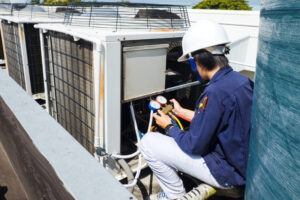
Unseen but omnipresent, air flows through our buildings, shaping the environments where we live, work, and play. For businesses and institutions, accurately measuring and controlling airflow is not just about comfort—it’s essential for energy efficiency, regulatory compliance, and occupant health. One such technological marvel that achieves these goals is the Airflow Measurement System (AFMS). This article provides a comprehensive overview of AFMS products, their setups, and how KMC’s approach stands apart.
What is an Airflow Measurement System (AFMS)?
An Airflow Measurement System is a blend of sensors, controllers, and actuators designed to actively measure, control, and optimize airflow in HVAC systems. These systems go beyond monitoring to ensure precise regulation of outdoor air, return air, and supply air in dynamic environments.
Typical Components of an AFMS Setup
AFMS setups can vary depending on the application, but generally include:
- Controllers with AFMS programming to convert data into actionable adjustments.
- Sensors for temperature, pressure, and damper position.
- Flow Pickup Tubes mounted in strategic locations to gauge air motion.
- Proportional Actuators that adjust damper positions to modulate airflow effectively.
Some systems, like the KMC AFMS, also feature diagnostic tools and advanced fault-detection capabilities to ensure performance over time.
Differing setups across manufacturers come down to a combination of decision criteria:
- Type of HVAC equipment: Different setups are needed for AHUs, RTUs, or VAV systems.
- Application requirements: Processes like precise airflow control for laboratories or hospitals demand unique configurations.
- Budget constraints: Balancing cost-efficiency with high accuracy influences design choices.
- Energy efficiency goals: Systems must align with efforts to minimize energy footprints while maintaining optimal air quality.
Common Challenges in Airflow Measurement Systems
Many environments face variables that make airflow measurements tricky, such as low air velocities, turbulence, airborne contaminants, or external weather impacts. Traditional measurement technologies like differential pressure and thermal dispersion sensors struggle with:
- Limited installation flexibility
- Frequent calibration needs
- Susceptibility to contaminants
KMC AFMS Difference
KMC addresses these issues by rethinking airflow measurement with a characterized damper system method. This innovative approach eliminates the dependency on duct conditions or mechanical restrictions. By utilizing a high-precision inclinometer, it provides consistent performance regardless of turbulence or damper deterioration.
How KMC AFMS Handles Airflow Measurement Better
KMC’s Airflow Measurement System incorporates several unique features that set it apart:
Innovative Characterization Method
Rather than relying on duct airspeed or pressure, KMC calculates airflow based on damper blade position. Its proprietary inclinometer ensures accuracy to 0.001° of deflection, bypassing the usual pitfalls of mechanical hysteresis or damper deterioration.
Automated Learning Mode
ASHRAE 111 recommends large temperature differentials (25°F-50°F) for airflow calibration. KMC’s system initiates characterization automatically once a 15°F+ differential is detected. This removes the guesswork and delivers reliable damper performance curves.
Pressure Assist for Complex Systems
For setups with relief fans, bypass dampers, or mixed air chambers, KMC’s pressure-assist feature fine-tunes airflow metrics to account for system anomalies.
Reduced Maintenance Effort
Unlike traditional methods requiring regular recalibration, KMC AFMS leverages self-diagnostics and fault detection for Title 24 compliance. Once installed, it minimizes operational oversight while ensuring long-term performance.
Improved Open Protocol Integration
Designed with interoperability in mind, KMC AFMS integrates seamlessly with any BACnet-compatible Building Automation System, offering flexibility across varied applications.
Real-World Applications of KMC AFMS
Learning about airflow measurement systems is great—but seeing them in action makes it real. Here are two success stories where KMC AFMS brought measurable improvements:
Healthcare Facilities
At Children’s Minnesota Hospital, KMC AFMS resolved complex pressurization issues. Its precise airflow measurements and automated diagnostics ensured compliance with healthcare-level air-quality standards, all while minimizing equipment maintenance.
Educational Facilities
Denver Public Schools leveraged KMC AFMS to enhance Indoor Air Quality (IAQ) and optimize ventilation costs. The system’s automated recalibration and integrated fault detection helped the district meet ASHRAE standards while saving on operational expenditure.
Why Choose KMC AFMS for Your Airflow Needs?
Airflow management is no longer an afterthought. It’s central to energy savings, compliance with IAQ standards, and ensuring environmental health for occupants. KMC AFMS offers a cost-effective, precise, and hassle-free solution to these challenges.
Key Benefits of KMC AFMS:
- Accurate measurement of outside, return, and supply airflow (within 3% error).
- Minimal maintenance effort due to automated recalibration.
- Full compliance with ASHRAE standards for energy efficiency and IAQ certifications.
- Real-time diagnostics that ensure predictable performance.
Take the Next Step
For businesses and institutions ready to upgrade their airflow capabilities, partnering with KMC means you’re choosing innovation backed by proven expertise. If you’d like to see how KMC AFMS can meet your specific needs, contact us today for a personalized walkthrough or demo of our system.
Understand airflow, revolutionize your space. Go with KMC AFMS.
[/vc_column_text][/vc_column][/vc_row]
 Cart
Cart